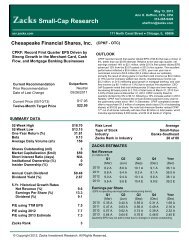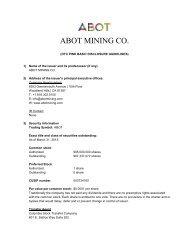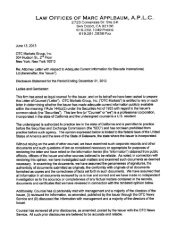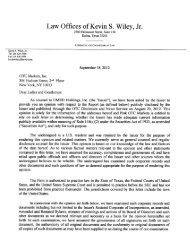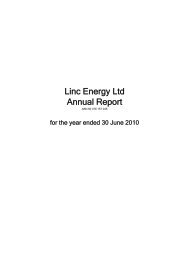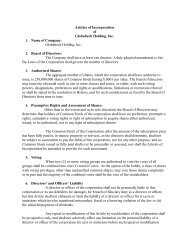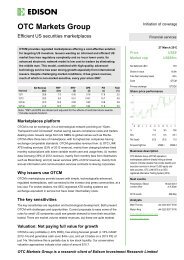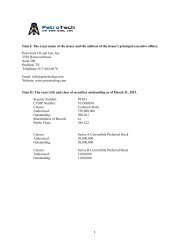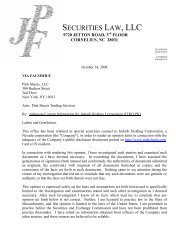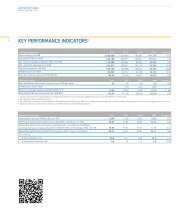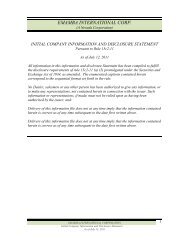2011 Annual Report - OTCIQ.com
2011 Annual Report - OTCIQ.com
2011 Annual Report - OTCIQ.com
Create successful ePaper yourself
Turn your PDF publications into a flip-book with our unique Google optimized e-Paper software.
Prepayments and accrued in<strong>com</strong>e<br />
Line item used to account for aperiodic expenses and in<strong>com</strong>e.<br />
Prepayments, which are recorded on the liability side of the<br />
balance sheet, occur when payment is made before the balance-sheet<br />
date, but the expense is after the balance-sheet<br />
date. Accrued in<strong>com</strong>e, which is recorded on the liabilities<br />
side of the balance sheet, occurs when payment is received<br />
before the balance-sheet date, but the in<strong>com</strong>e is recorded<br />
after the balance-sheet date.<br />
Purchase price allocation<br />
In a business <strong>com</strong>bination accounted for as a purchase, the<br />
values at which the acquired <strong>com</strong>pany’s assets and liabilities<br />
are recorded in the acquiring <strong>com</strong>pany’s balance sheet.<br />
Rating<br />
Standardized performance categories for an issuer’s short-<br />
and long-term debt instruments based on the probability of<br />
interest payment and full repayment. Ratings provide investors<br />
and creditors with the transparency they need to <strong>com</strong>pare<br />
the default risk of various financial investments.<br />
Return on equity<br />
The return earned on an equity investment (in this case,<br />
E.ON stock), calculated after corporate taxes but before an<br />
investor’s individual in<strong>com</strong>e taxes.<br />
ROACE<br />
Acronym for return on average capital employed. A key indicator<br />
for monitoring the performance of E.ON’s business, ROACE<br />
is the ratio between E.ON’s EBIT and average capital employed.<br />
Average capital employed represents the interest-bearing<br />
average capital tied up in the E.ON Group.<br />
ROCE<br />
Acronym for return on capital employed. ROCE is the ratio<br />
between E.ON’s EBIT and capital employed. Capital employed<br />
represents the interest-bearing capital tied up in the E.ON<br />
Group.<br />
Stock appreciation rights (“SAR”)<br />
Virtual stock options in which <strong>com</strong>pensation is in cash instead<br />
of in stock. At E.ON, the exercise gain equals the difference<br />
between the price of E.ON stock on the exercise date and at<br />
the time the SAR were issued.<br />
CEO Letter<br />
E.ON Stock<br />
Combined Group Management <strong>Report</strong><br />
Consolidated Financial Statements<br />
Corporate Governance <strong>Report</strong><br />
Supervisory Board and Board of Management<br />
Tables and Explanations<br />
Syndicated line of credit<br />
Credit facility extended by two or more banks that is good<br />
for a stated period of time.<br />
Tax shield<br />
Deductions that reduce an enterprise’s tax burden. For example,<br />
the interest on corporate debt is tax deductible. An enterprise<br />
takes this into consideration when choosing between equity<br />
and debt financing (see Cost of capital).<br />
Underlying net in<strong>com</strong>e<br />
An earnings figure after interest in<strong>com</strong>e, in<strong>com</strong>e taxes, and<br />
minority interests that has been adjusted to exclude certain<br />
extraordinary effects. The adjustments include effects from the<br />
marking to market of derivatives, book gains and book losses<br />
on disposals, restructuring expenses, and other non-operating<br />
in<strong>com</strong>e and expenses of a non-recurring or rare nature (after<br />
taxes and minority interests). Underlying net in<strong>com</strong>e also<br />
excludes in<strong>com</strong>e/loss from discontinued operations, net.<br />
Value added<br />
Key measure of E.ON’s financial performance based on residual<br />
wealth calculated by deducting the cost of capital (debt and<br />
equity) from operating profit. It is equivalent to the return<br />
spread (ROCE minus the cost of capital) multiplied by capital<br />
employed, which represents the interest-bearing capital tied<br />
up in the E.ON Group.<br />
Value at risk (“VaR”)<br />
Risk measure that indicates the potential loss that a portfolio<br />
of investments will not exceed with a certain degree of probability<br />
(for example, 99 percent) over a certain period of time<br />
(for example, one day). Due to the correlation of individual<br />
transactions, the risk faced by a portfolio is lower than the sum<br />
of the risks of the individual investments it contains.<br />
Working capital<br />
The difference between a <strong>com</strong>pany’s current assets and<br />
current liabilities.<br />
207



